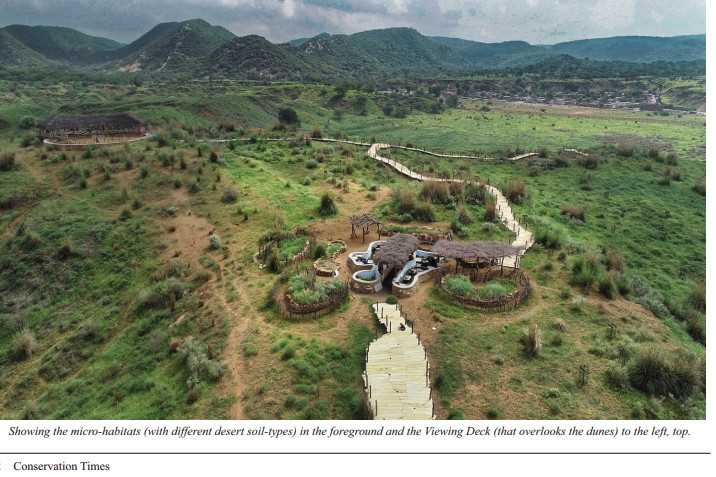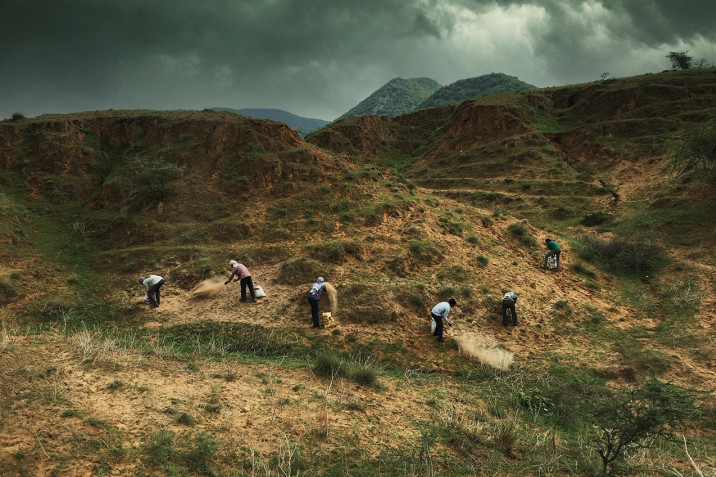By Rosamma Thomas
A freelance journalist based in Pune, Maharashtra, India
email: [email protected]

If Rajendra Singh is India’s award winning waterman, then Pradip Krishen is the nation’s plantman. The former filmmaker has for over a decade been working with the Mehrangarh Fort Trust in Jodhpur, where the Rao Jodha Desert Rock Park now stretches over 70 hectares near the Fort, with over 300 species of plants. Krishen is a champion of “rewilding”, or restoring degraded landscapes by prodding nature along, so it takes its course. For the first time in his life, the 70-yearold is now working with a government agency, Jaipur Development Authority. He is working to restore degraded lands at the foot of the Nahargarh Fort in Rajasthan state capital Jaipur. At the foot of the hill, there is an “obstructed dune” – a sand dune that in the normal course would sweep forward but finds itself blocked by the hill. Sand has now piled up at the bottom of the hill, and water has carved pathways down this dune. Kishan Bagh, the restored landscape here that Krishen has been working on since 2016, is set to be open to visitors soon. Describing how he came to begin work on this site, Krishen says he was invited by the government to recreate some of his work in Jodhpur in the state capital. He was shown municipal parks; those did not interest him, there’s little scope of re-wilding a park. That was when the state government horticulturists took him to the foot of Nahargarh Hill in northwest Jaipur – it looked like the Chambal ravines, he said. The sight excited him, and he began to think of what he could do there. While he worked in Jodhpur, Krishen would travel often into the desert areas along the border with Pakistan, and he discovered, from asking a local person who herded camels, that the traditional name for the scrubland in the deserts where camels could feed was “Roee”. The sandy dune landscape was called Thull – in Pakistan, the Thar desert is now called Thal, and it is clear that this local word was the root of the Anglicized “Thar”. Krishen says he wanted visitors to experience the Roee of the desert, and so he brought elements of the desert to the Kishan Bagh, shifting even a large boulder that had been naturally splintered. Visitors will see now how plants grow through the crevices of rocks. Desert landscapes these days are highly degraded and fragmented, with the profusion of mining activity and the thinning of natural vegetation. Renewable energy projects – solar panels and windmills — too have disturbed the rugged beauty of these landscapes. At Kishan Bagh in Jaipur, a visitor might get a sense of what the Roee was, before human intervention interfered with the natural vegetation. Most Roees in Rajasthan have three common plants, that locals call Seenio (Crotalaria burhia), Bui (Aerva pseudo-tomentosa) and Kheemp (Leptadenia pyrotechnica), Krishen explains. The plants in the desert change according to the composition of soil; even so, these three plants are quite common. The interpretation spaces in the new park will expose visitors to similar scrublands in other parts of the world – large photographs will allow visitors to see how such areas are conserved in other countries. “If they can do it, why not us?” That should be the question visitors pose. There is a section of Kishan Bagh that will have the traditional dhok (Anogeissus pendula) – a variety of tree found only in the Aravalli range. It can survive with little water in rocky soil on the hill. “These are clonal forests,” Krishen explains. The trees appear like separate trees, but in reality, their root system is all meshed underneath, so actually the trees are all linked. This is the vegetation on the Nahargarh Hill too, and a section of the park has been planted with dhok so visitors can see it up close. Pradip Krishen expresses dismay that forest officials in India think of the desert as “wasteland”, and that governments often try and green these areas, channeling water to them from long distances away. The Indira Gandhi Canal was also planned to bring water from Punjab to the Rajasthan desert. Although the cultivation of crops became possible with the canal, diseases like malaria, that desert people had never known before, also arrived. The rise in the water table from irrigation caused soluble salts to rise closer to the surface, causing decline in crop yields and creating new wastelands. The work undertaken in Jodhpur and Jaipur could make people stop and think about the desert and see how this interesting natural landscape waits to be better understood
